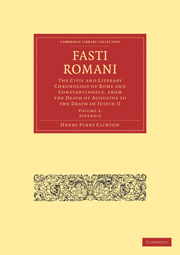 Fasti Romani
Fasti Romani 3 - INDICTIONS. ERA OF DIOCLETIAN. ERA OF ANTIOCH
Published online by Cambridge University Press: 03 May 2011
Summary
IT has been shewn in a former work that the era of Antioch was reckoned from Nov. 1 B.C. 49 U. C. Varr. 705. The first year therefore of Antioch was nearly conumerary with the 264th year of the Selewcidœ, which commenced in October B. C. 49 U. C. Varr. 705. But if the first year was conumerary with the 264th, the 301st of Antioch, with which this Table begins, was conumerary with the 564th of the Seleucidœ.
That the era of Diocletian was reckoned from his accession in A. D. 284 is determined by Theon ad Ptolemæi μ∈y. σuvTαξ. who attests that the 29th day of Aihyr in the year of Nabonassar 1112 fell within the 81st year of Diocletian. Aihyr 29 of the 1112th year was Nov. 25 A. D. 364, and the 81st year of Diocletian was then current. But if the 81st year was current Nov. 25 A. D. 364, the first was already current Nov. 25 A. D. 284, and we are carried back to his accession Sept. 17. It is probable however that in Alexandrian computation the years of this era were deduced from Aug. 29, as in the Alexandrian coins of Diocletian given in the Tables at A. D. 285 p. 328.
The Indictions in Marcellinus and in the Tables of Du Fresnoy torn. 1 p. 174 are compared with the consulship and the Julian year in which they end. In the following Table they are compared with the years in which they begin, because the years of the Christian era are here made the measure of the rest and contain the beginnings of all the other epochs.
- Type
- Chapter
- Information
- Fasti RomaniThe Civil and Literary Chronology of Rome and Constantinople, from the Death of Augustus to the Death of Justin II, pp. 210 - 216Publisher: Cambridge University PressPrint publication year: 2010First published in: 1850


